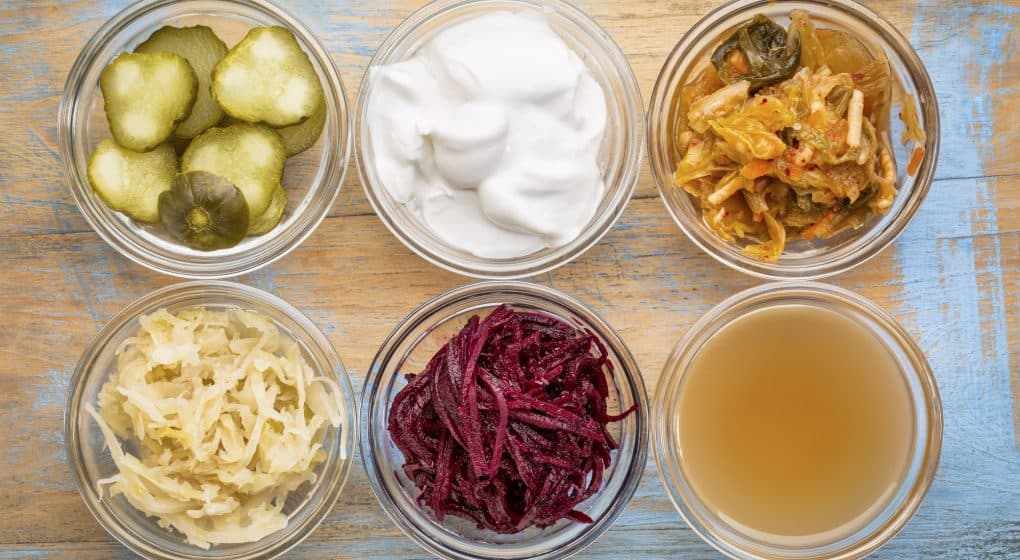
Fermented foods have good bacteria, probiotics. You might have already heard that consuming probiotics will help improve your digestion and give many more benefits, such as reducing inflammation.
Besides fighting inflammation, probiotics will boost your mood and increase your energy levels. Generally, the bacteria give an overall healthy immune system. Seeing that the immune system of your body is centered around your gut, probiotics living there influence the overall health you enjoy.
While you can get probiotics from supplements, most fermented foods are natural sources of these bacteria. The benefit of consuming these fermented foods to supplementing is that fermented foods will give you other beneficial nutrients too. The acidic by-products of probiotics are useful in breaking down nutrients during digestion for added benefits. This breakdown reduces bloating and cramps.
Below are some of the top fermented foods to reduce inflammation.
1. Kombucha
Kombucha is made as a mix of SCOBY, which is a colony of bacteria and yeast living symbiotically and green or black tea. The drink has been taken for more than 2000 years, but it is only recently that it started gaining popularity. As the drink ferments, the SCOBY added will eat away the sugars from the tea to produce B vitamins, organic acids, and probiotics.
Kombucha is shown to produce a unique strain of probiotic thanks to the SCOBY culture. SCOBY culture includes Saccharomyces boulardii which has a myriad of added benefits for your digestion and also fights dermatitis.
More research is needed on the benefits of Kombucha. However, the fact that Kombucha has probiotics means that it reduces inflammation and better your mood. Research has also shown that the tea in Kombucha produces polyphenol compounds which have several health benefits including reduced blood sugar and cholesterol levels, reduced rate of getting some cancers, improved gut and liver. Kombucha further contains glucaric acid which detoxifies the body.
According to the Center for Disease Control, Kombucha should be taken in moderation. CDC recommends 4 ounces each time for up to three times a day. You should not take more than 12 ounces of Kombucha in a day. Again, you should not rely on Kombucha as your only source of probiotic; you need to have an upgraded probiotics regimen to include other drinks.
2. Kefir
Kefir is a drink that looks and tastes like yogurt. The drink is made by fermented milk with kefir grains to have a drink thinner and tangier than yogurt. Kefir grains offer a culture of symbiotic bacteria and yeast which are held together by polysaccharide produced by Lactobacillus higarii.
Kefir has more beneficial probiotics than yogurt making it a great choice for those who need to reduce inflammation and improve overall gut health. The drink also contains vitamin K2, B Vitamins, and tryptophan, which is an essential amino acid that stimulates the production of serotonin – serotonin stabilizes your mood.
Kefir has a tangy taste. This makes many brands to add a lot of sugar, which might reduce the health benefits associated with Kefir. To rip the most benefits off the drink, always go for unsweetened Kefir and better its flavor by adding cinnamon or blend the drink with berries.
3. Kimchi
Kimchi is Korean food. It is a great source of probiotics, and as such, it reduces inflammation, especially along the gut and your skin. The drink is a result of fermented vegetables, especially cabbages, with lactic acid bacteria. There are other bacteria that can be used for the fermentation process but lactic acid bacteria are important in the production of probiotics.
The fermented cabbage can be used as a salad dressing or can be taken alone. When taken, the cabbage has several health benefits including weight loss, fights metabolic syndrome, prevents cancer growth, and reduces inflammation.
It is easy to make Kimchi at home as all you need are the lactic acid bacteria.
4. Lacto-Fermented Pickles and other vegetables
Pickling is sometimes confused for fermenting, but these two are different. While both these methods preserve food, pickling preserves food in salt or salty water or a liquid such as vinegar while fermenting uses bacteria to preserve food.
Pickled foods, especially vegetables and fruits, are good sources of probiotics to enhance your gut health and reduce inflammation. The reason why pickled food produces probiotics is that most of these foods are also fermented. Good examples of these are lacto-fermented pickles and sauerkraut, which are easily formed through lactic acid fermentation.
When you are shopping for pickled and fermented vegetables, pick those that are raw and unpasteurized or those that are lacto-fermented. This way, you are sure that the probiotics are alive and will propagate in your gut.
5. Sauerkraut
Sauerkraut is a lacto fermented pickle that offers a horde of digestive health benefits. It is mostly used as a sandwich topper. When taken, the pickle provides your body with fiber, which helps feed the probiotic bacteria in your gut to help digestion run smoothly and reduce inflammation. The drink also contains vitamin C and vitamin K for immunity and strong bones, respectively.
Just like when shopping for other fermented pickles, ensure that the Sauerkraut you buy is freshly made and labeled ‘raw and unpasteurized’ for maximum benefits. Sauerkraut should be refrigerated and not canned since the pasteurization process that canned pickles go through kills of much of the bacteria. You can also make Sauerkraut easily at home and take it fresh.
6. Tempeh
Tempeh is a product of fermented soybeans. It is rich in complete protein, which is crucial in muscle growth and repair. If you are a plant-based dieter, this fermented food might be a great source of proteins. The food is great because it takes on the flavor of any food it is cooked with. Besides reducing inflammation, Tempeh boosts bone strength and reduces cholesterol levels.
Like any other soy food, Tempeh is rich in omega-3 fatty acids, which reduce the risk of heart disease and improve your brain’s health. The isoflavone phytochemicals in soy are important in reducing postmenopausal bone loss and reduce the growth of some cancers. You can easily make Tempeh at home.
7. Miso
Miso has been used for hundreds of years in Asian cuisines to give its savory umami flavor. Besides being used as an additive in other foods, Miso is a good source of iron, potassium, calcium, protein, and B vitamins. Miso is fermented, giving it all the beneficial probiotics. It also has a strain of bacteria shown to have digestive health benefits such as reducing symptoms of inflammatory bowel disease. When adding Miso to your food, add it hot recipes less than a minute towards the end of your cooking. This way, beneficial bugs are not destroyed by heat. If you do not like Miso soups, you can make Miso paste.
8. Yogurt
Yogurt is the most common fermented food that fights inflammation. Unless you pick a brand that is loaded with sugar, yogurt will always have great benefits. Yogurt is milk fermented with lactic acid bacteria, making it a great choice for your gut health. According to research, yogurt is responsible for increase in the number of beneficial bacteria in your gut. This is a good thing seeing that a reduced number of beneficial bacteria in the gut can increase susceptibility to certain conditions such as diabetes type 2, obesity, inflammatory diseases, and irritable bowel syndrome.
Yogurt is a rich source of proteins with the Greek yogurt having up to 20 grams of complete proteins per serving. It also has calcium which maintains blood sugar level and boosts your bone health.
9. Nattokinase
Natto is a common Japanese food made from fermented soybeans. The food is mostly taken as breakfast mostly with soy sauce or karashi mustard. When it ferments, Natto develops a strong flavor and a slimy, sticky texture. When it ferments, it produces probiotics that can fight inflammation and other gut conditions.
Conclusion
During the process of fermentation, the natural sugars in food are broken down by bacteria and yeast into substances that are more beneficial. The products of fermentation are full of beneficial probiotics and other useful nutrients.
There are different types of fermentation with most leading to the production of beneficial probiotics. Wild fermentation occurs when microbes already in food or found in the air start the fermentation process. Lacto-fermentation occurs when there are Lactobacillus bacteria in food. Culturing is the type of fermentation where a microbial starter is added to food to kick start the fermentation process.
If you have not been taking fermented foods, it is important that you introduce them slowly in your diet. These foods are very powerful and might cause some GI distress when taken in large amounts.
It is important to note that not all fermented foods have probiotics. Bread and apple cider vinegar, among other fermented foods and drinks, may be beneficial to probiotics already in your gut but they do not have probiotics in them. When preparing fermented foods, ensure that you do not kill the probiotics as this will render the food useless.
Your body already has probiotics naturally. These fermented foods only supplement what you have. As such, there is no dosage to these fermented foods, as most of them cannot harm the body. However, if the intake of a given fermented food such as Kombucha has been restricted to a dose, adhere to the restrictions as the food might be too powerful.
